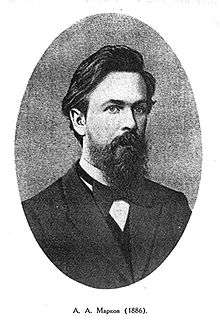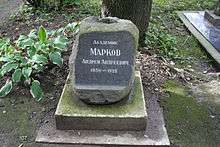Andrey Markov
| Andrey (Andrei) Andreyevich Markov | |
|---|---|
 | |
| Born |
14 June 1856 N.S. Ryazan, Russian Empire |
| Died |
20 July 1922 (aged 66) Petrograd, Russian SFSR |
| Residence | Russia |
| Nationality | Russian |
| Fields | Mathematician |
| Institutions | St. Petersburg University |
| Alma mater | St. Petersburg University |
| Doctoral advisor | Pafnuty Chebyshev |
| Doctoral students | |
| Known for | Markov chains; Markov processes; stochastic processes |
Andrey (Andrei) Andreyevich Markov (Russian: Андре́й Андре́евич Ма́рков, in older works also spelled Markoff[1]) (14 June 1856 N.S. – 20 July 1922) was a Russian mathematician. He is best known for his work on stochastic processes. A primary subject of his research later became known as Markov chains and Markov processes.
Markov and his younger brother Vladimir Andreevich Markov (1871–1897) proved Markov brothers' inequality. His son, another Andrei Andreevich Markov (1903–1979), was also a notable mathematician, making contributions to constructive mathematics and recursive function theory.
Biography
Andrey Markov was born on the 14th of June 1856 in Russia. He attend Petersburg Grammar, he was seen as a rebellious student by a select few of teachers. In his academics he performed poorly in most subjects other than mathematics (which later became his profession). Later in life he attended Petersburg University and was lectured by Pafnuty Chebyshev. Among his teachers were Yulian Sokhotski (differential calculus, higher algebra), Konstantin Posse (analytic geometry), Yegor Zolotarev (integral calculus), Pafnuty Chebyshev (number theory and probability theory), Aleksandr Korkin (ordinary and partial differential equations), Mikhail Okatov (mechanism theory), Osip Somov (mechanics), and Nikolai Budaev (descriptive and higher geometry). He completed his studies at the University and was later asked if he would like to stay and have a career as a Mathematician. He later taught at high schools and continued his own mathematical studies. In this time he found a practical use for his mathematical skills. He figured out that he could use chains to model the alliteration of vowels and consonants in Russian literature. He also contributed to many other mathematical aspects in his time. He died at age 66 on the 20th of July 1922.
Andrey Markov Timeline
In 1877, Markov was awarded a gold medal for his outstanding solution of the problem
About Integration of Differential Equations by Continuous Fractions with an Application to the Equation .
During the following year, he passed the candidate's examinations, and he remained at the university to prepare for a lecturer's position.
In April 1880, Markov defended his master's thesis "About Binary Quadratic Forms with Positive Determinant", which was encouraged by Aleksandr Korkin and Yegor Zolotarev.
Five years later, in January 1885, there followed his doctoral thesis "About Some Applications of Algebraic Continuous Fractions".
His pedagogical work began after the defense of his master's thesis in autumn 1880. As a privatdozent he lectured on differential and integral calculus. Later he lectured alternately on "introduction to analysis", probability theory (succeeding Chebyshev, who had left the university in 1882) and the calculus of differences. From 1895 through 1905 he also lectured in differential calculus.

One year after the defense of his doctoral thesis, Markov was appointed extraordinary professor (1886) and in the same year he was elected adjunct to the Academy of Sciences. In 1890, after the death of Viktor Bunyakovsky, Markov became an extraordinary member of the academy. His promotion to an ordinary professor of St. Petersburg University followed in the fall of 1894.
In 1896, Markov was elected an ordinary member of the academy as the successor of Chebyshev. In 1905, he was appointed merited professor and was granted the right to retire, which he did immediately. Until 1910, however, he continued to lecture in the calculus of differences.
In connection with student riots in 1908, professors and lecturers of St. Petersburg University were ordered to monitor their students. Markov refused to accept this decree, and he wrote an explanation in which he declined to be an "agent of the governance". Markov was removed from further teaching duties at St. Petersburg University, and hence he decided to retire from the university.
Markov was an atheist. In 1912 he protested Leo Tolstoy's excommunication from the Russian Orthodox Church by requesting his own excommunication. The Church complied with his request.[2][3]

In 1913, the council of St. Petersburg elected nine scientists honorary members of the university. Markov was among them, but his election was not affirmed by the minister of education. The affirmation only occurred four years later, after the February Revolution in 1917. Markov then resumed his teaching activities and lectured on probability theory and the calculus of differences until his death in 1922.
See also
Notes
- ↑ E.g. Shannon, Claude E. (July–October 1948). "A Mathematical Theory of Communication" (PDF). Bell System Technical Journal. 27 (3): 379–423. doi:10.1002/j.1538-7305.1948.tb01338.x.
- ↑ "Of course, Markov, an atheist and eventual excommunicate of the Church quarreled endlessly with his equally outspoken counterpart Nekrasov. The disputes between Markov and Nekrasov were not limited to mathematics and religion, they quarreled over political and philosophical issues as well." Gely P. Basharin, Amy N. Langville, Valeriy A. Naumov, The Life and Work of A. A. Markov, page 6.
- ↑ Loren R. Graham; Jean-Michel Kantor (2009). Naming Infinity: A True Story of Religious Mysticism and Mathematical Creativity. Harvard University Press. p. 69. ISBN 978-0-674-03293-4.
Markov (1856–1922), on the other hand, was an atheist and a strong critic of the Orthodox Church and the tzarist government (Nekrasov exaggeratedly called him a Marxist).
References
- Karl-Georg Steffens (28 July 2007). The History of Approximation Theory: From Euler to Bernstein. Springer Science & Business Media. pp. 98–105. ISBN 978-0-8176-4475-8.
- А. А. Марков. "Распространение закона больших чисел на величины, зависящие друг от друга". "Известия Физико-математического общества при Казанском университете", 2-я серия, том 15, ст. 135–156, 1906.
- A.A. Markov. "Extension of the limit theorems of probability theory to a sum of variables connected in a chain". reprinted in Appendix B of: R. Howard. Dynamic Probabilistic Systems, volume 1: Markov Chains. John Wiley and Sons, 1971.
http://blog.wolfram.com/2013/02/04/centennial-of-markov-chains/ Andrey Markov Jnr
▪ Markov Biography - Extracted from a number of sources "written by Joseph Brooks" 2016 Markov early life: Russia, Petersburg.
External links
| Wikimedia Commons has media related to Andrey Markov. |
- Andrei Andreyevich Markov at the Mathematics Genealogy Project
- O'Connor, John J.; Robertson, Edmund F., "Andrei Andreyevich Markov", MacTutor History of Mathematics archive, University of St Andrews.
- Biography of A.A. Markov by his son, A.A. Markov-jnr (Russian)
- Works by or about Andrey Markov in libraries (WorldCat catalog)